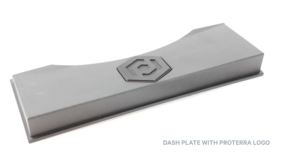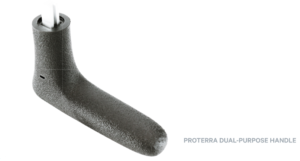Revolutionizing Mass Transit with 3D Printing: Proterra & Carbon Create Two New Parts for Electric Buses
 3D printing has made fantastic strides in the automotive industry, but not always in the most conventional of ways. While the technology has found its place at BMW, Ford, and even Rolls Royce, you never know where else 3D printed parts will turn up. From production of 3D printed cars from Local Motors to the Olli Bus—not to mention a variety of DIY racecars and motorcycle parts—automotive enthusiasts on every level are able to enjoy the benefits of 3D printing today.
3D printing has made fantastic strides in the automotive industry, but not always in the most conventional of ways. While the technology has found its place at BMW, Ford, and even Rolls Royce, you never know where else 3D printed parts will turn up. From production of 3D printed cars from Local Motors to the Olli Bus—not to mention a variety of DIY racecars and motorcycle parts—automotive enthusiasts on every level are able to enjoy the benefits of 3D printing today.
Now, Silicon Valley’s Proterra is on a mission to transform global mass transportation issues, using 3D printing manufacturing techniques from Carbon. Already famous for their innovation with electric buses, Proterra continues to play a major role in creating commercial vehicles that leave as little environmental footprint as possible. With 3D printed parts for their buses, manufacturing costs are eliminated by a staggering 90-95 percent—and can be installed in the buses within two weeks (rather than the typical three months for conventional parts manufactured through injection molding).
This new partnership in production was the subject of a recent case study by Carbon, highlighting the use of their Digital Light Synthesis technology. While offering a more positive environmental impact played a big role in exploring 3D printing, Proterra was able to enjoy all the benefits—from efficiency and affordability, to the ability to make strong yet lightweight parts.
Proterra works with customers varying in order volumes. One may order two vehicles, while another orders 25. Each bus has around 4,000 parts, most of which have historically been injection molded.
“The economic model of the commonly-used injection-molding (IM) manufacturing method breaks down when the quantity of end-production parts needed is small. The typical injection-mold development and tooling cost can be anywhere between $25,000 and $50,000 for low-to-medium complexity small parts and between $100,000 and $400,000 for more complex larger parts. For example, if one customer orders only 10 buses, the estimated cost for a medium-complexity, injection-molded part unique to that customer can be as high as $5,000 (=$50,000/10) each. This is one of the most critical challenges for organizations everywhere that require high-quality, low-volume production parts,” stated Carbon in their case study.
Proterra used M Series 3D printers to create two different types of parts, using rigid polyurethane (RPU): the first is a handle designed with ergonomics and dual purpose in mind, operating as both a door switch handle and a tool for gaining entry to access panels. The second part is a custom dash plate (again, made from RPU) featuring the Proterra logo.
“The final Carbon part looked better than any injection-molded part I have previously seen for comparable dash plates,” said Proterra engineer Trey Underwood.
Along with creating improved, high performance parts, Proterra was able to eliminate the need for both tool makers and materials suppliers. Digital Light Synthesis™ technology allows for a ‘single point of ownership,’ preventing recurring problems with parts and delays overall.
“3D Manufacturing with Carbon overcomes the injection-molding tooling requirements when volumes are low,” said Joshua Stewart, Director of Customer Engineering at Proterra. “At Proterra, there are no barriers to utilizing 3D manufactured parts on our vehicles if the quality and economics meet our requirements. Carbon’s technology has exceeded these requirements.”
Read more on the case study regarding Proterra and Carbon’s work here.
What do you think of this news? Let us know your thoughts! Join the discussion of this and other 3D printing topics at 3DPrintBoard.com or share your thoughts below.
[Source / Images: Carbon]
Subscribe to Our Email Newsletter
Stay up-to-date on all the latest news from the 3D printing industry and receive information and offers from third party vendors.
You May Also Like
Precision at the Microscale: UK Researchers Advance Medical Devices with BMF’s 3D Printing Tech
University of Nottingham researchers are using Boston Micro Fabrication‘s (BMF) 3D printing technology to develop medical devices that improve compatibility with human tissue. Funded by a UK grant, this project...
3D Printing Webinar and Event Roundup: April 21, 2024
It’s another busy week of webinars and events, starting with Hannover Messe in Germany and continuing with Metalcasting Congress, Chinaplas, TechBlick’s Innovation Festival, and more. Stratasys continues its advanced training...
3D Printing Webinar and Event Roundup: March 17, 2024
It’s another busy week of webinars and events, including SALMED 2024 and AM Forum in Berlin. Stratasys continues its in-person training and is offering two webinars, ASTM is holding a...
3D Printed Micro Antenna is 15% Smaller and 6X Lighter
Horizon Microtechnologies has achieved success in creating a high-frequency D-Band horn antenna through micro 3D printing. However, this achievement did not rely solely on 3D printing; it involved a combination...
































